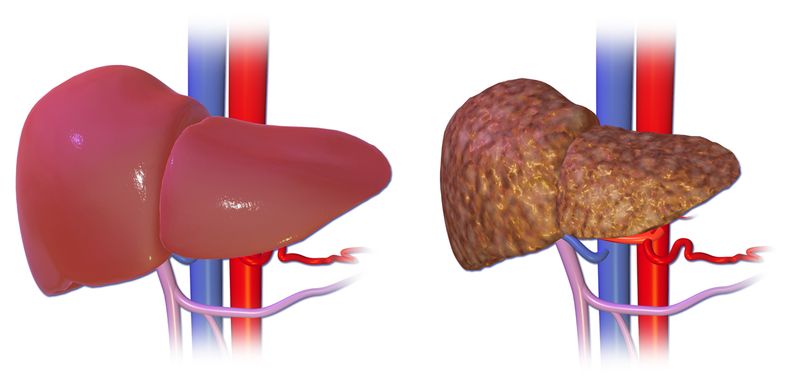Liver cirrhosis is the ultimate consequence of many liver diseases and chronic poisoning. Cirrhosis is usually associated with chronic hepatic disease causing chronic hepatitis (hepatitis) , which causes continuous necrosis and hepatic lobe regeneration to cause liver cirrhosis (cirrhosis). Cirrhosis is the result of multiple liver damage and healing. Cirrhosis is a strong risk factor for liver cancer (hepatoma) .
Cirrhosis of the liver
Hepatic regeneration capacity is high. Even in normal operation, the liver lobes function as a filter of blood coming from the intestines and the body, and similar to the oil filter in the car, they need more frequent replacement. Closed and damaged liver lice die and are replaced by new ones. However, as with any healing, even in liver regeneration, scar tissue (fibrous) is produced. If the liver is overloaded with chronic infection or intoxication, the rate of scar tissue formation is much higher. Heavily loaded liver gradually builds up so much collagen that by his volume prevents the regeneration of new liver beams. The liver is hard on the palate as a sinewy snout - that is why it is called cirrhosis ( hardening of the liver ).
Consequences of cirrhosis
Once cirrhosis develops, most of the liver volume is made up of useless collagen tissue. The remaining useful liver volume does not suffice for the need to filter the blood returning the portal vein from the intestines and the digestive tract. The situation is the same as for each filter - due to reduced throughput, venous pressure increases in all parts of the digestive tract, which include the esophagus, the stomach, the small intestine, and the large intestine. Especially the esophagus is prone to varicose veins in the vein overpressure - the diseased extensions of the esophagus. Circulatory liver is not enough to purify blood, LDL cholesterol increases in blood and accumulates waste particles. This contributes to the rapid development of atherosclerosis . In addition, cirrhotic liver is trying to regenerate new beams, but there is no place. This leads to continuous attempts of liver cells (in which mutations are already accumulated due to previous inflammations and poisoning) to divide and susceptibility of a patient with cirrhosis to primary liver cancer (hepatoma). In summary, cirrhosis of the liver creates a syndrome of mutually reinforcing pathological tendencies that significantly shorten the life of the affected person.
Protection against cirrhosis
Once cirrhosis develops, it is incurable. If liver transplantation is over, it is best to protect your liver from chronic inflammation by hygiene, healthy lifestyle and hepatoprotective adaptogens. The existence of hepatoprotective (liver-protecting) plants and fungi is real, but it is not entirely clear what all these are and how their effects are compared to each other. In this situation, I recommend that you rely on the tradition of TČM and maybe also Ayurveda, to which we add at least of our herbs at least the Marshmallow .
Otherwise, the herb protecting herbs includes both the model plant ginseng adaptogen and the gloss gloss glossy model adaptation sponge . The hepatoprotective effect of ginseng is not significant. According to the Lo2011gri study, ginsenoside ginsenoside Rb 1 acts against the formation of fibrotic tissue in the liver and according to Tark2015egr , this ginsenoside (Rb 1 ) also has a potential positive effect on remodeling of scar tissue, which gives some hope to patients with already developed cirrhosis. The antifibrotic effect of gloss glossy in the liver is documented in the Kwon2011aaf and Sudheesh2012glp studies . A list of other liver-protecting adapters can be found under the motto of liver disease .
